South America is a very different place today then it was when I frequented the continent between the mid 80ies and late 90ies. Back then it was the US’ back-yard – no government however democratic and popular with it’s own people could survive if it didn’t have the US administration’s consent – i.e. if it didn’t apply neoliberal economic policies. The only exception which confirmed that rule was Cuba and perhaps not because the US hadn’t tried every dirty trick to rid the region of Mr Castro but precisely because “El Viejo” was neither democratic or particularly popular with his own people. Even after the cold war was finished, successive US administrations applied all their influence (using all means necessary, including violence) to keep dictators or pseudo democratic regimes in power as long as they, in turn, agreed to continue to apply the disastrous neoliberal dogma. The consequences for the vast majority of the local population were devastating – as banks and public utilities were deregulated and privatised (usually to multinationals that paid little local tax) unemployment and inequality grew. For decades the system was evidently not sustainable but the folly continued until the situation eventually imploded towards the end of the C20th. Luckily, at least for the citizens of Latin America, the US abruptly changed its geo-political priorities following 9/11 – communism (which in WASP eyes included social democracy) was no longer public enemy No1. The new enemy was now in Afghanistan – apparently, the Taliban and Al-Qaida religious fanatics, having defeated the USSR, had turned their hate to those other infidels – once their allies, paymasters and arm suppliers – the USA. Then the USA decided to topple another former ally in a geopolitically sensitive region (which just happened to have a plentiful supply of fossil fuels), Sadam Hussein.
The US has not totally abandoned its policies of interfering in the domestic politics of Latin American nations; they recently backed abortive coups in both Venezuela and Ecuador – and successful ones in Honduras in 2009 and Paraguay in 2012, however, their influence there has indisputably waned. While Latin America’s left-leaning governments have no shortage of failings, from corruption to crime they have done much to improve the lives and living standards of their peoples by reversing the neoliberal politics pursued in previous decades. Unfortunately however, the Western Media’s coverage of the area does not change; they routinely portray these democratic governments as being dictatorial while still being apologetic for past US backed regimes which had far worse human right’s records – as in many other reporting world-wide this says more about the failings of our own information institutions than the subjects being analyzed.
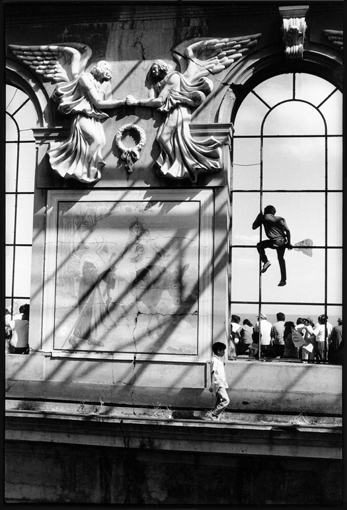
V-001
Managua, Nicaragua
Managua Cathedral, Nicaragua.
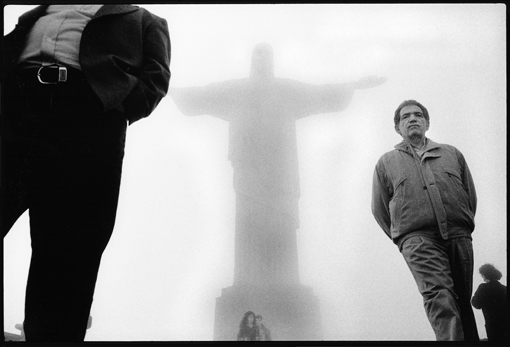
V-002
Rio, Brasil
Rio De Janeiro, Brazil.
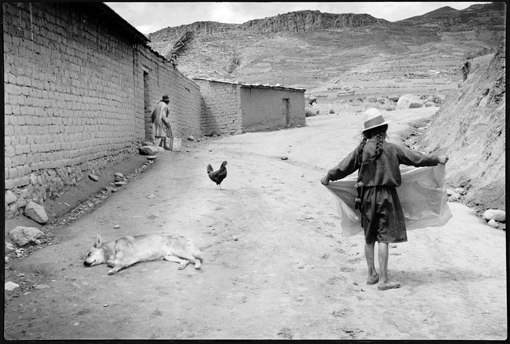
V-003
Bolivia
Aymara village, Bolivia.
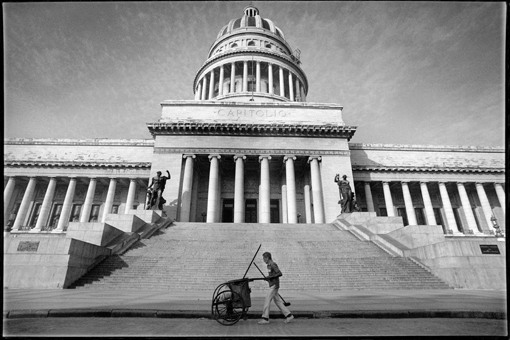
V-004
Cuba
The Capitolio, Havana, Cuba.
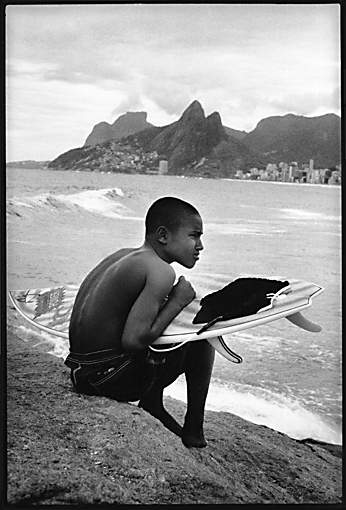
V-005
Rio, Brasil
Rio de Janeiro, Brazil.
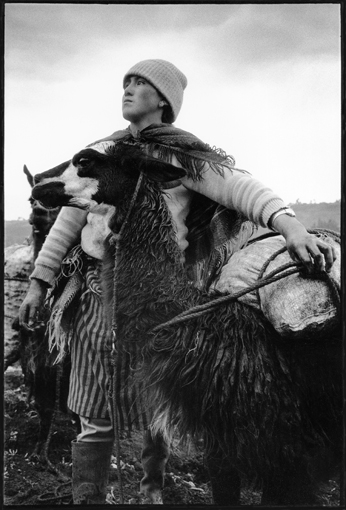
V-006
Ecuador
Young mother during potato harvest. Ecuador.
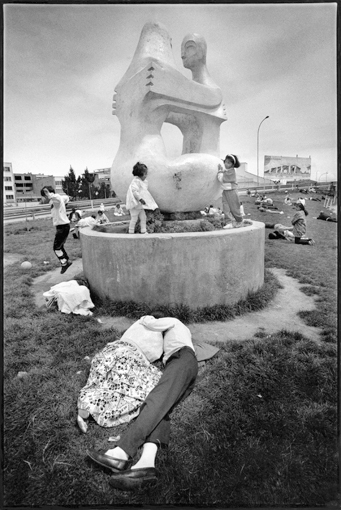
V-007
Bolivia
Young couple in the only "park" in El Alto (alt. 3800m). Bolivia.
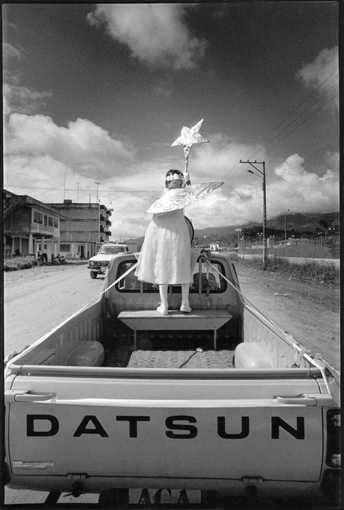
V-008
Ecuador
An angel leaves after Christmas day celebrations in eastern Ecuador.
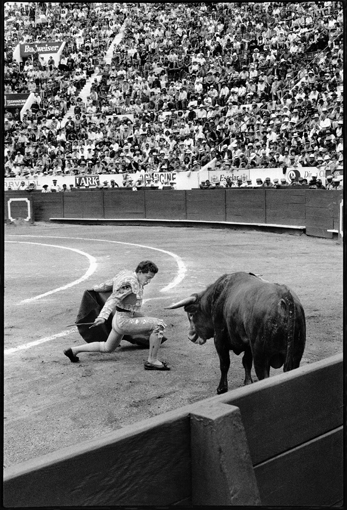
V-009
The Matador, Ecuador
The Matador before the final kill during a bullfight in Quito, Ecuador.
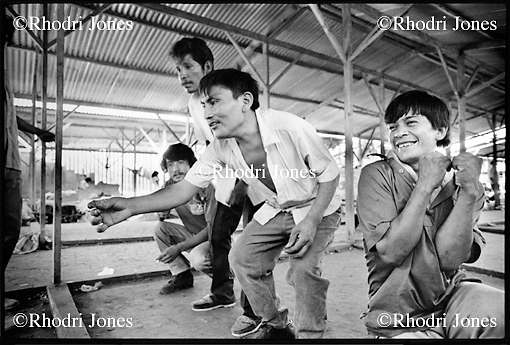
V-010
El Salvador
Four drunks in the San Salvador Central market. El Salvador.
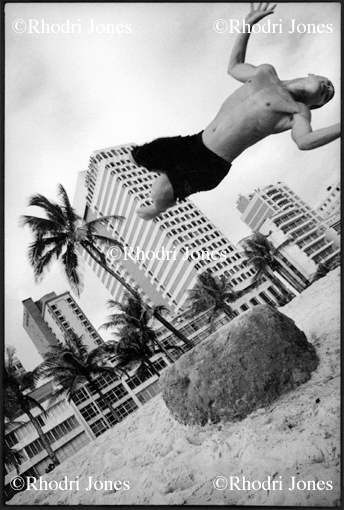
V-011
Rio, Brasil
Rio de Janeiro, Brazil.
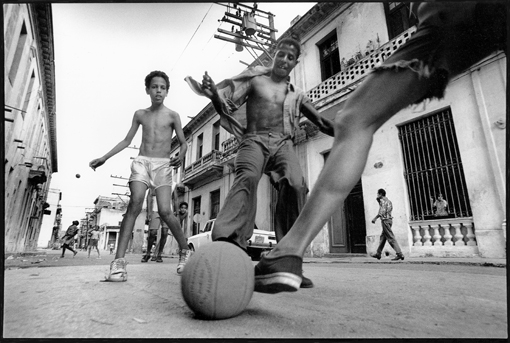
V-012
Havana, Cuba
Youngsters play football in the backstreets of old Havana, Cuba.
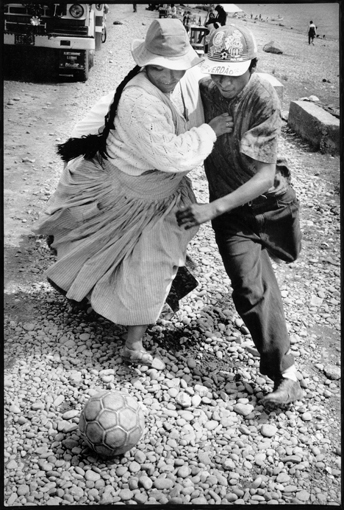
V-013
Titicaca , Bolivia
A young couple play football on the banks of lake Titicaca (3800 m) during Easter weekend. Bolivia.
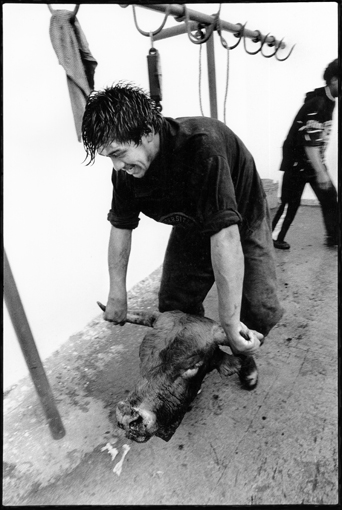
V-014
The butcher, Ecuador
Behind the scenes of a bullfight, the butcher. Quito, Ecuador.
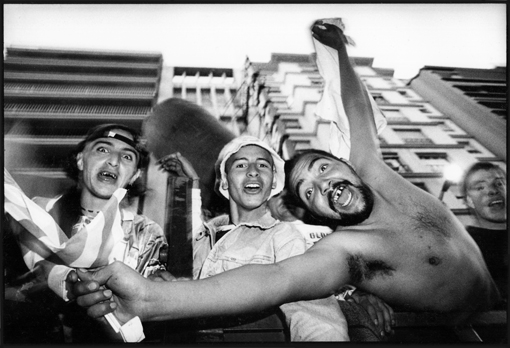
V-015
Montevideo, Uruguay
Uruguay fans celebrate a football match victory in Montevideo.
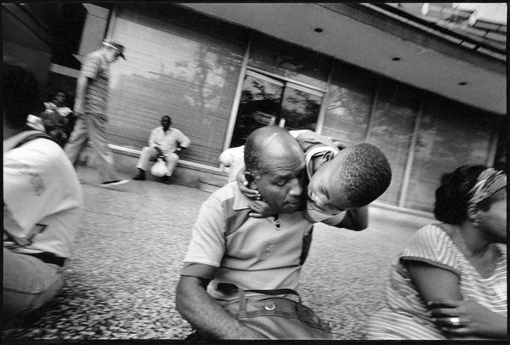
V-016
Havana, Cuba
Old Havana. Cuba.
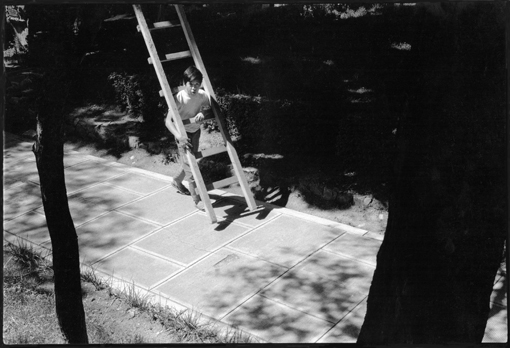
V-017
Child Labour, Bolivia
Child Labour, a "grave cleaner" in the cemetery of Sucre, the old capital of Bolivia.
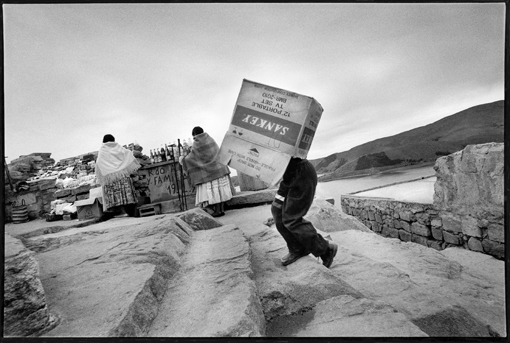
V-018
Cocacabana, Bolivia
A youth takes shelter during a shower on "Cavalries Hill". This has been a religious site for at least a millennium and for three different faiths; that of the Aymara, then the Inca and finally the Catholic faith. Cocacabana, lake Titicaca (alt. 3800m). Bolivia.
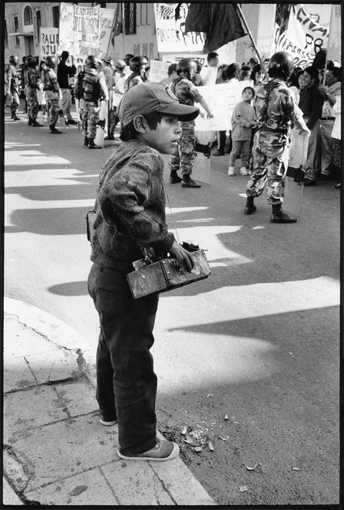
V-019
Shoeshine, Ecuador
Shoeshine boy looks on at a demonstration against the privatisation of public services (water, electricity etc) in Quito. Ecuador.
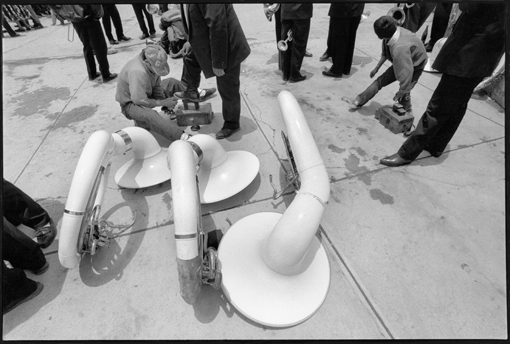
V-020
Child Labour, Bolivia
Shoeshine boys hit lucky, a brass band in El Alto (alt. 3800m). Bolivia.
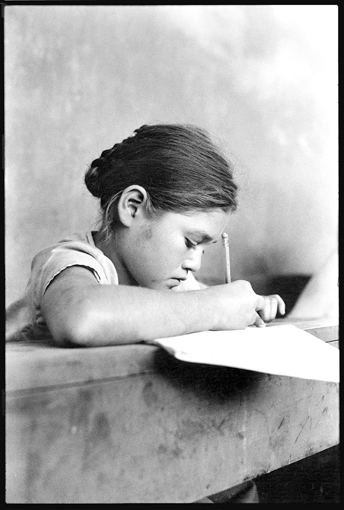
V-021
Santa Martha, El Salvador
Young pupil in class in Comunidad Santa Martha, a cooperative commune of returned war refugees in a zone controlled by the FMLN (left wing insurgents) during the civil war in El Salvador.
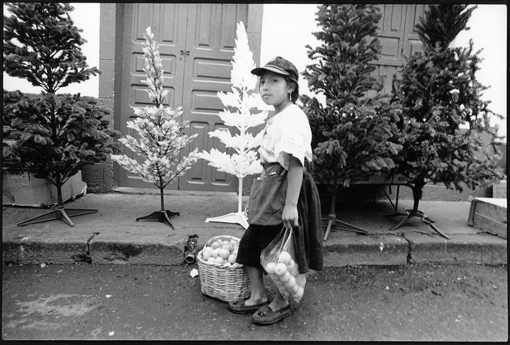
V-022
Child Labour, Ecuador
Girl selling fruit in the central market Quito. Ecuador.
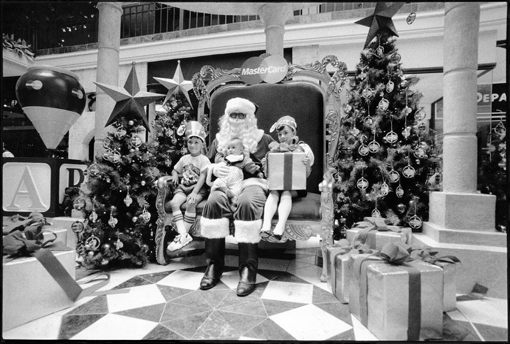
V-023
Xmas, Ecuador
Father Christmas in a shopping centre. Quito, Ecuador.
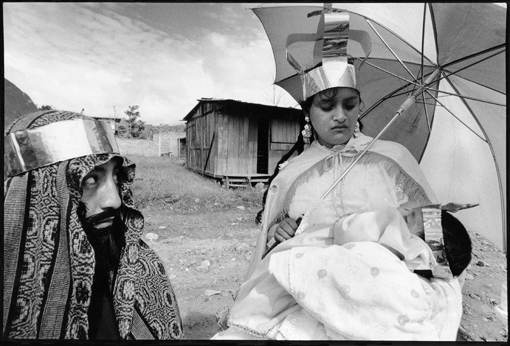
V-024
Nativity, Ecuador
Mary, Joseph and Jesus in Christmas celebrations in a small town in southern Ecuador.
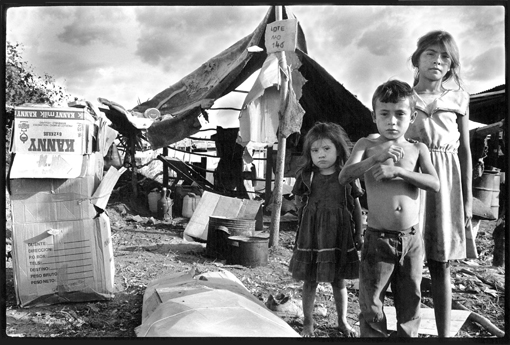
V-025
Squat, El Salvador
Children living in squat 146 on the municipal waste tips of San Salvador during the civil war in El Salvador.
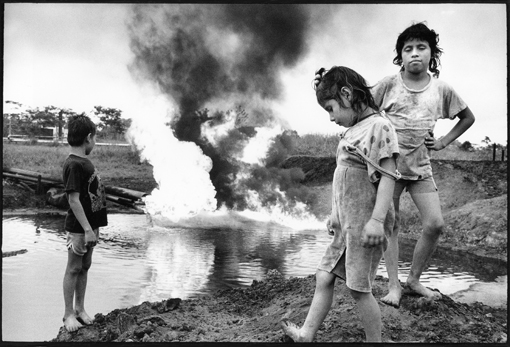
V-026
Oil, Ecuador
Oil and gas exploitation, South East Ecuador.
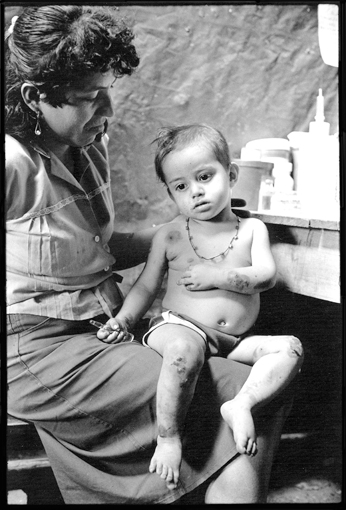
V-027
Medical clinic, El Salvador
Medical clinic in Comunidad Santa Martha, a cooperative commune of returned war refugees in a zone controlled by the FMLN (left wing insurgents) during the civil war in El Salvador.
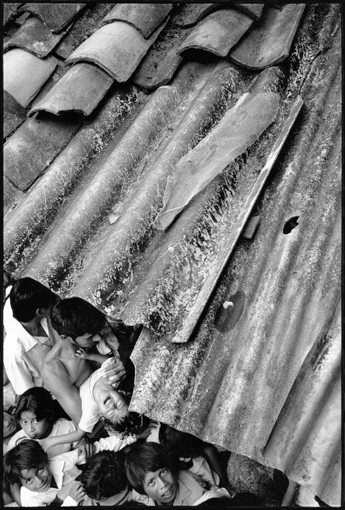
V-028
Internally displaced, Ecuador
Internally displaced following conflict between Peru and Ecuador. Southern Ecuador.
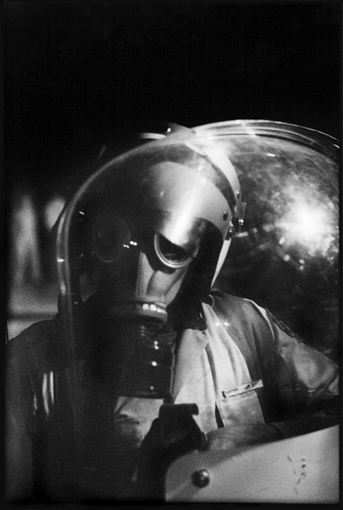
V-029
Riot Police, Nicaragua
Sandinista armed forces face down protesters after the Sandinista Party lost the 1990 elections. Nicaragua.
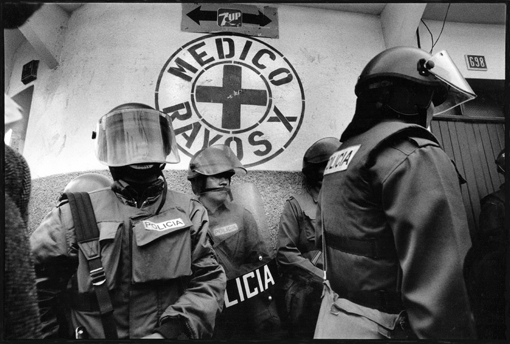
V-030
Riot police, Bolivia
Riot police during demos protesting against the privatization of national oil and gas companies. Despite being unpopular and against the will of the majority of the people, Neo Liberal policies continued to be imposed in much of Latin America. La Paz, Bolivia.
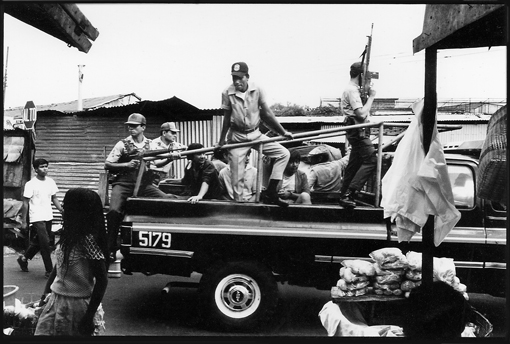
V-031
Guardia Nacional, El Salvador
A pick-up with people detained by the Guardia Nacional in a central market San Salvador.
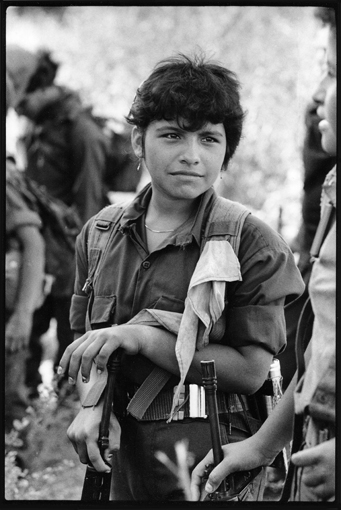
V-032
FMLN, El Salvador
Young FMLN fighter. The civil war between successive extreme right wing governments (with US backing) exploded in 1981 after the murder by government death squads of Archbishop Romero and continued until 1991. With over 60000 deaths (mostly civilians) it was one of the most tragic in Latin American history.
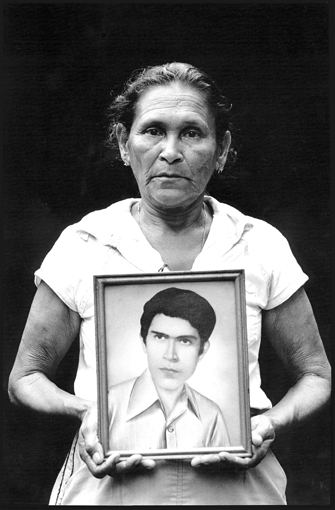
V-033
Dona Tina, El Salvador
Dona Tina with one of the three sons she lost in the civil war. El Salvador. The civil war between successive extreme right wing governments (with US backing) exploded in 1981 after the murder by government death squads of Archbishop Romero and continued until 1991. With over 60000 deaths (mostly civilians) it was one of the most tragic in Latin American history.
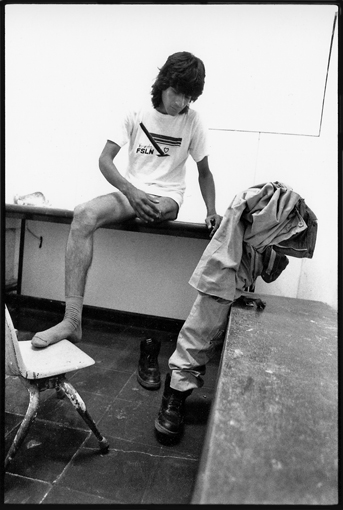
V-034
Luis, Nicaragua
Luis laid mines while a conscript with the Sandinista troops during the "Contra" conflict. One day he stepped on an anti-personnel mine he himself had laid, he was 19 yrs old at the time. Managua, Nicaragua.
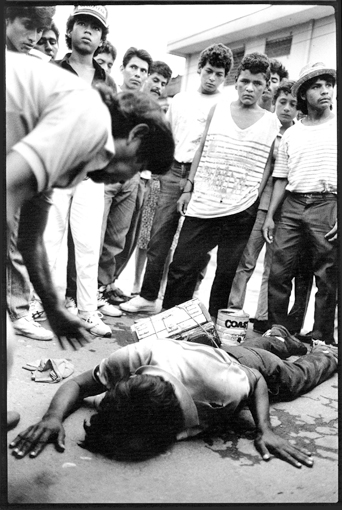
V-035
Civilian Victim, El Salvador
Rosendo "Chino" Oluri (57yrs) was a market porter. He was shot by riot police while participating in a demo against the introduction of Neo Liberal policies, i.e. the privatization of public oil and gas companies. Despite being unpopular Neo Liberal policies continued to be adopted throughout Latin America. La Paz, Bolivia.
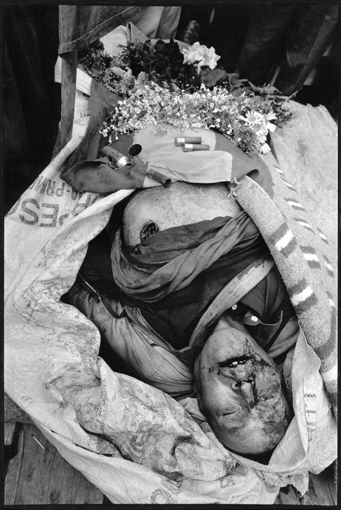
V-036
"Cino", Bolivia
Rosendo "Chino" Oluri (57yrs) was a market porter. He was shot by riot police while participating in a demo against the introduction of Neo Liberal policies, i.e. the privatization of public oil and gas companies. Despite being unpopular Neo Liberal policies continued to be adopted throughout Latin America. La Paz, Bolivia.
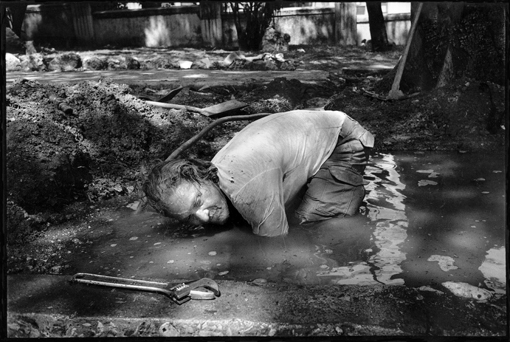
V-037
Municipal worker, Cuba
Municipal worker fixes sewerage system in Havana. Cuba.
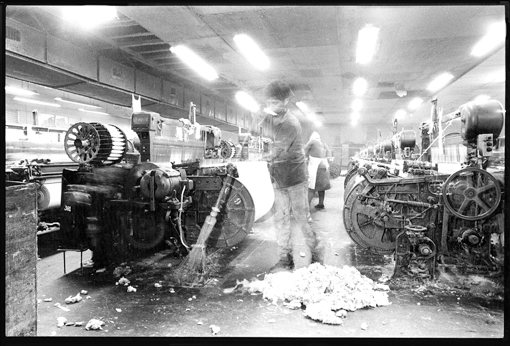
V-038
Cotton factory, Nicaragua
Cotton factory in Managua, Nicaragua. Up to the Sandinista revolution in 1979, the factory was owned by the dictator's family, indeed Samosa privately owned 80% of all industry and over 50% of the land. In 1979 the factory was nationalized but was again privatized in 1991 shortly before it was shut.
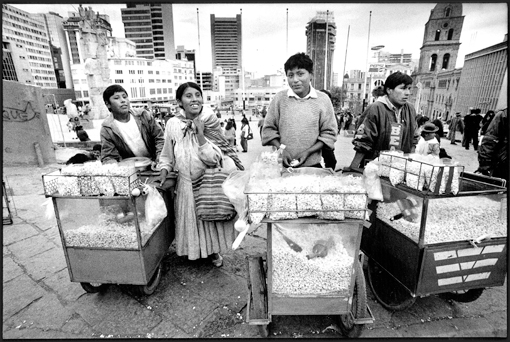
V-039
Street Traders, Bolivia
Popcorn sellers in central La Paz. Bolivia.
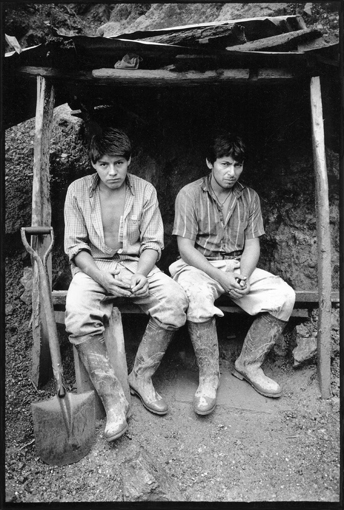
V-040
Coop miners, Ecuador
Cooperative miners, Nambija goldmines. The land is owned by the military which sublet to local coops and, increasingly, to large foreign mining companies. Southern Ecuador.
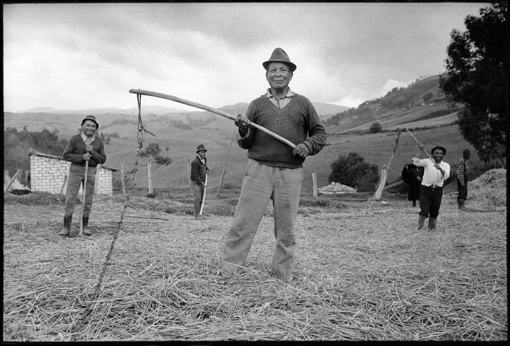
V-041
Farm hands, Ecuador
Farm hands on a local estate during harvest. Ecuador.
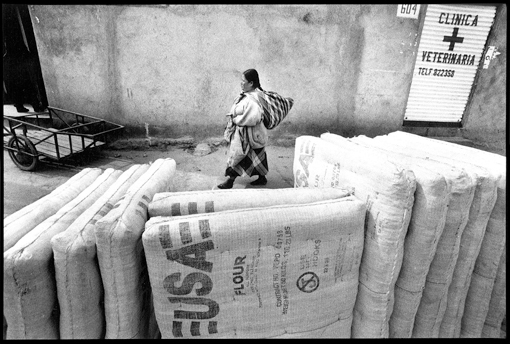
V-042
Mattrasses, Bolivia
Mattresses made from old flour sacks on sale in El Alto. Bolivia.
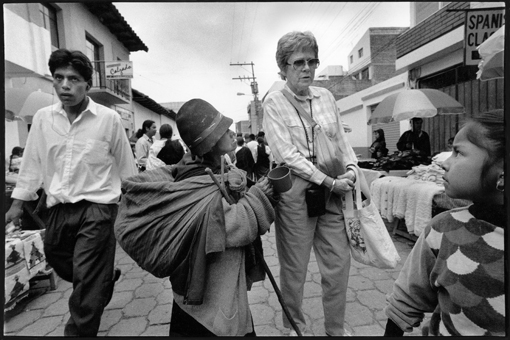
V-043
Beggar, Ecuador
Beggar and US tourist. Chiborazo, Ecuador.
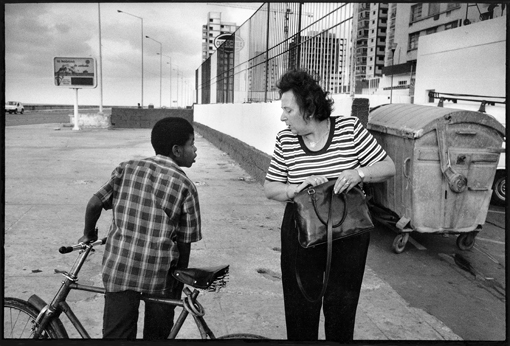
V-044
Beggar, Cuba
Youth asks a tourist for money in Havana. Cuba.
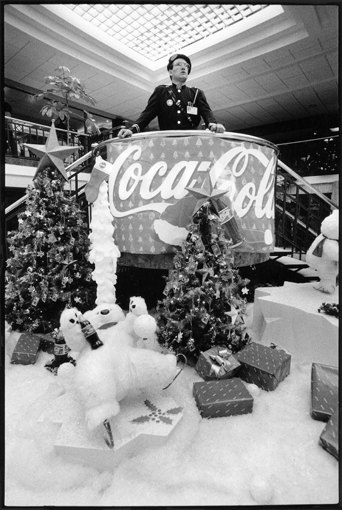
V-045
Shopping centre, Ecuador
A private security guard in a Quito shopping centre. Ecuador.
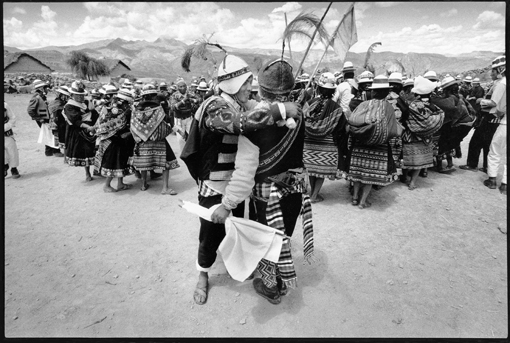
V-046
Aymara, Bolivia
Ten Aymara communities gather each year for these carnival celebrations in Northern Potosi Province. Bolivia.
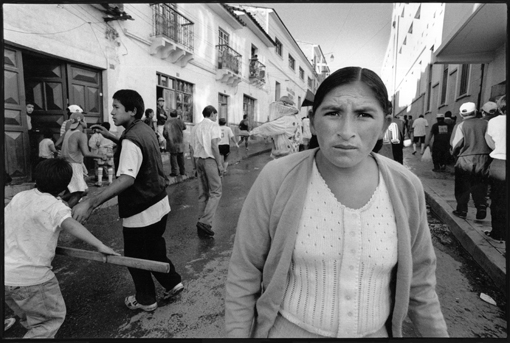
V-047
Sucre, Bolivia
During Carnival in the streets of Sucre, once Bolivia's capital.
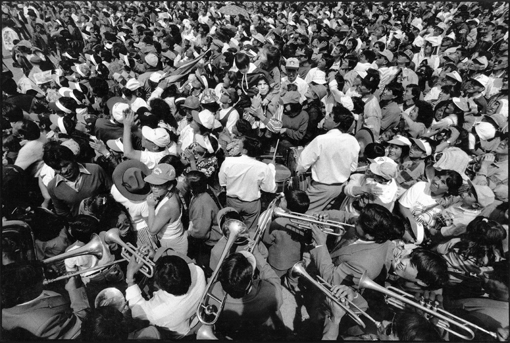
V-048
Quito, Ecuador
A crowd at fireworks display. Quito, Ecuador.
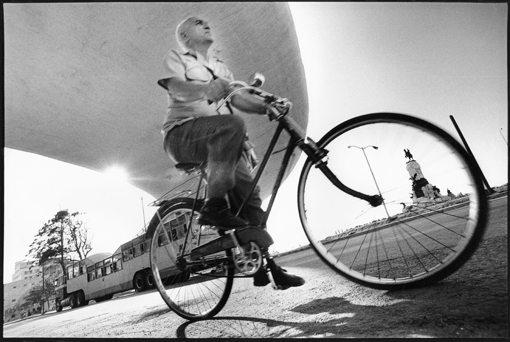
V-049
Havana, Cuba
Cyclist in Havana, Cuba.
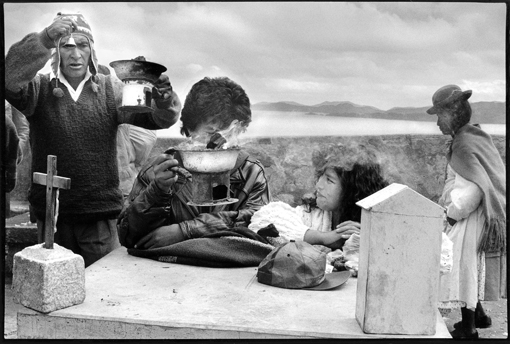
V-050
Easter, Bolivia
Easter weekend, Cocacabana, lake Titicaca (3800m). This has been a religious site for at least a millennium and three different faiths; that of the Aymara people, then the Inca and finally the Catholic faith. The local shaman rites are a mixture of all three faiths and are guaranteed to improve anything from one's financial status to fertility ... at a moderate price. Bolivia.
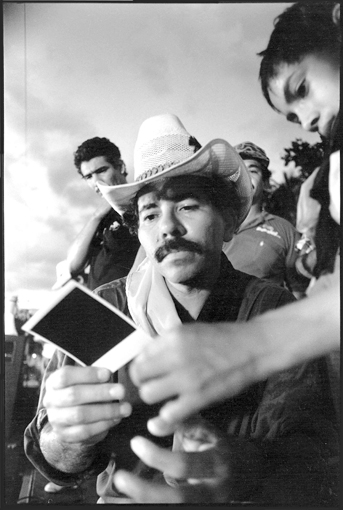
V-051
Ortega, Nicaragua
Daniel Ortega, the Sandinista President of Nicaragua during the 1990 General Elections which the FSLN lost.
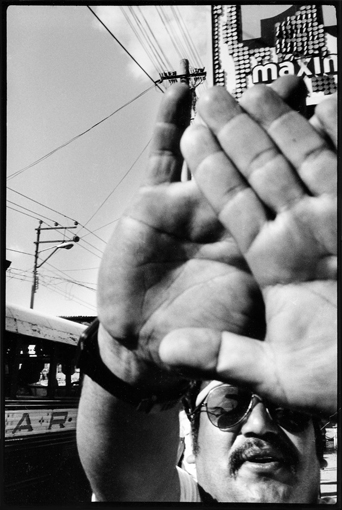
V-052
Assault, El Salvador
An Arena government supporter (extreme right wing) assaults the photographer during 1991 election campaign. El Salvador.